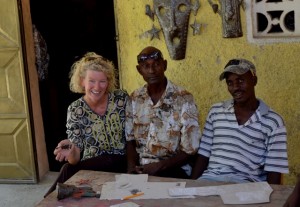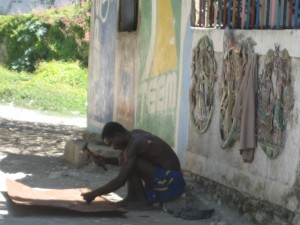How Much Money Goes Back to the Artists?

Casey, the indispensable Franz, and Jean Rony in Jean’s workshop. Discussions in progress!
If we’ve heard that question once, we’ve heard it a thousand times. And it’s a good one. The quick response is, “None goes back, because we pay 100 percent up front. They get paid first.” But that isn’t really a complete or direct answer, is it? (Yeah, I know, I kind of dodged it.) Still, it’s a hard question to answer because there isn’t one “absolutely all-the-time” firm, formulaic response. (I think I just saw you roll your eyes…)
Let me start by saying that we negotiate the price for every new piece we order. Artists tell us what they would like to get, and we consider what end price the market will bear. If we can compensate them at their asking price, cover our costs, and turn their pieces over quickly in the marketplace, we’ve got the magic number. Dealing is done. But sometimes the magic number comes after going back to the pencil and paper a time or two. Sometimes the artists have to re-think what they hope to make. Or sometimes we say, “Okay, we’ll try it at that price and see if it moves. ” And we’ve even said, “Oh, we can do better for you than that. Let’s go higher.”

Sculpture al fresco in Haiti.
I can tell you honestly that I have watched these discussions a hundred times, and all of those responses have occurred. Generally, the more experienced the artist, the better feel he has for pricing. His asking price and our buying price are easily matched and settled with a smile and handshake. We’ve been doing this successfully for a while now and so have they. Together, we’ve learned that these exchanges yield the best results for everybody. It’s all good!
So then what?
The artist receives his order, for say thirty of his “Flower with Hummingbird” designs. At the time he receives that order, he also receives full payment for all thirty pieces. In this way, we not only meet, we exceed fair trade practice guidelines, which set a 50% minimum. One month later, the art is delivered to our warehouse. In other words, we absorb all of the risk. If a flood washes out the workshop, the loss is ours. Not everyone works on those terms, but we do. Always have, always will.
And there you have it. The answer is somewhat circuitous, but the clear result is win-win. (Oh! I just saw you roll your eyes again…)
Contributed by Linda for It’s Cactus
